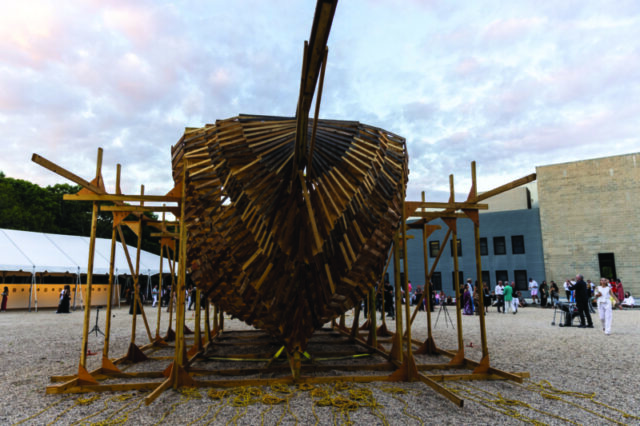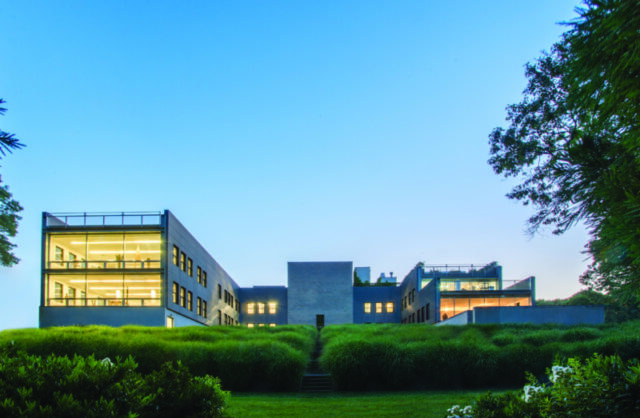
By Ray Rogers
Ray Rogers: You’re on the road most of the year, so it’s nice to catch you here at The Watermill Center.
Robert Wilson: I travel a lot—for about 58 years I’ve been on the road. I try to spend as much time here as I can. As I get older, I just turned 80, I hope to spend more time out here in Water Mill. I also have a place in Manhattan, but I haven’t been there in a year.
RR: Do you consider this to be your home?
RW: Yeah, I do. I could’ve very easily lived in Paris, I was offered a very beautiful theater in Paris. And a couple years before that I had a similar offer in Hamburg. They were going to give me what had been a crematorium to make into a cultural center. I thought about moving there, but I met Man Ray in the mid-’70s. Much to my surprise, I’d had a very big success in 1971, with a work called “Deafman Glance” which was seven hours long in silence. I never expected to have a career in the theater. It was a phenomenal success. I got to go to La Scala, the Berlin Opera, opera houses in Amsterdam and Rome… I found a very nice apartment in Paris and I thought maybe I would move there. And I met Man Ray shortly before he died; he said, “If you want to, you can have my studio.” But he said, “Bob, I advise you not to move to Paris, because I became an expatriate and I always regretted that I did. I think you should stay in your homeland.” And somehow when he said that it just clicked.
RR: What was the impetus for The Watermill Center?
RW: I wanted to do what in some ways I couldn’t do in the U.S., here. My first work was created [around] Raymond Andrews, an African American deaf mute boy [whom Wilson ended up adopting]—he’d never been to school, and he was silent—it was based on observations and drawings of the boy. Helping to shape and form the work was Daniel Stern, who was head of the department of psychology at Columbia University. He was a scientist, and he was doing studies of preverbal communications between mothers and babies, so he was fascinated by Raymond Andrews, who as far as we could tell knew no words. And this bond became very important in my life, as an artist working with a scientist, getting his viewpoint on the way Raymond thought.
And later, [the poet and painter] Christopher Knowles came to live with me. Chris wasn’t really appreciated or understood here, but in France…we performed in major theaters across Europe. Here, they wrote, Robert Wilson takes advantage of a brain-damaged child and puts him onstage. It was just the opposite. But at The Center it didn’t seem to be a problem. You could bring people that normally wouldn’t come together in a new center for creative thinking that could produce work.
I wanted to have an open-door policy here, so we could bring people from other nations to the U.S., as a creative center, creating new work [exploring] the history of man. I think that’s important for a center for creative thinking, that we look to the past. It’s important that we support our community on Long Island, our forefathers in the Shinnecock Nation. They lived on this land, had this land. To make this community rich, it’s important that we are aware of what’s happening in Guatemala, in Vietnam, in Afghanistan… It’s a balance between supporting our local community and the community at large, supporting what man has done in the past with the balance of what we’re doing today with creation.
RR: In what ways has The Watermill Center impacted the community here on the East End and vice versa?
RW: Our communities need centers. When I was studying architecture, Sibyl Moholy-Nagy taught the history of architecture. She said, ‘Students, you have three minutes to design a city.’ I drew an apple and inside the apple I drew a crystal cube. [He sketches this out.] She said, ‘What is that?’ I said, ‘It’s a plan for a city.’ Communities need something like a crystal cube inside of the apple to reflect the universe, to reflect the world and the people. It’s a place where music is performed and written, painters are painting, it’s a center of the city. I see this as a kind of center here on Long Island for creative thinking. You enter from the street, down here on Towd Road, there’s no gate, there’s no door. You can walk all the way through the building, we have an open-door policy. The Bible says, “Behold, I have set before you, an open door.”

RR: Your use of light has been a hallmark of what you do. Has the famed light of the Hamptons had any effect on your work?
RW: I think so. Last night, we were eating and I said to everyone, ‘Stop, look at the sky!’ It was incredible, the light. It’s very beautiful early in the morning here, and this room faces east, with the sunlight coming in among the sculptures. Each community has a special light. When I was a student and traveling through Europe, I went to Belgium, and I thought oh my god, this light. Each country has a special light. Greece has a special light. Paris has a special light; that’s why painters have gone there for centuries. But the light of Long Island—this long island along the ocean—is extraordinary.
RR: What effect did growing up in Texas as a gay boy have on how or why you create?
RW: Well, I knew I wanted to get away from the right-wing community. I grew up in a community where it was a sin to go to the theater—a theater was a house of ill repute. It was a sin if a woman wore pants, it was a sin to go to a movie. It was frowned upon if you walked down the street with a Black man. It was very segregated. I knew I wanted to get away from that environment, so I came to New York, and it was very liberating, and I stayed here ever since. Alec [Wilson’s assistant] and I just went back to Waco, Texas.
RR: What was it like to be back?
RW: It was nice. It had been a long time! We are building an arts center. We had an exhibition. I might even design a park adjacent to it. The vegetation and the oak trees were so beautiful. We were there in the spring and the wildflowers looked so beautiful along the highway.

RR: How has The Watermill Center grown over the course of the decades?
RW: This summer we had a young man who ran the summer program whose father had been here, and he came as a child. Now he’s 37. I hear all the time about people who were here for a program and met someone from a different country or a different lifestyle or a different occupation or interest, how they bonded and collaborated and worked together. I’m still fighting to keep it so it doesn’t get too big and institutionalized.
RR: When you started out, what did you think you’d be doing? You said it was a surprise to you that you ended up in the theater.
RW: I had no idea. When I was 21 I met Martha Graham. She said, “Mr. Wilson, what do you want to do in life?” I said, “Ms. Graham, I have no idea, I don’t do anything well.” She said, “Well, if you work long enough and hard enough, you’ll find something!” That stuck with me. Nine times out of 10 maybe nothing works, but then something happens.
RR: What role do you see art and artists playing in today’s world?
RW: Art serves a unique function in society; it’s like fire—it can destroy you or it can keep you warm. By looking at theater or music, you can bring people together, regardless of their political, social or economic backgrounds and for a short period of time you are able to share something. And politics will always divide men. Religion will always divide men. But art has the possibility of uniting men, and bringing people together. I think it’s a necessity in human nature to congregate.
RR: Purist has a focus on wellness. Do you have a meditation practice or something you do to keep you mentally healthy?
RW: We have a morning meeting where everyone gathers in the big room, and we sit together on the floor. For the first 10 or 15 minutes, I don’t say anything; I just sit. Someone said a couple weeks ago, Are you meditating? I said, No, I’m just sitting. But we start the day quietly with no one talking. Then we organize the day and go about doing chores and things—who needs help with whatever projects they’re working on, we work together… Very often in the evening I’ll just stand there in the room and not say anything. They’ll ask me, what are you doing? And I’ll say, I want to listen to the land.
RR: What’s exciting you now?
RW: I have a big project with Philip Glass and Lucinda Childs, based on the life of Stephen Hawking, that we’re creating and taking to Hamburg. After months in a wheelchair [due to a back injury], I’ll be in Berlin in physical therapy to get my strength back. For months I couldn’t walk. Now I’m walking with a cane, and I’m excited about that. I’m going to Lithuania to do a work there, and to Spain to make a work with nonprofessionals, with people from the streets. I’m doing a sound installation in Paris, and something in Weimar. All of that’s exciting to me.
RR: You’re busy!
RW: This old man is still kicking.





